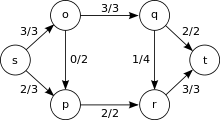最大流问题
在优化理论中,最大流问题涉及到在一个单源点、单汇点的网络流中找到一条最大的流。
最大流问题可以被看作是一个更复杂的网络流问题(循环问题,circulation problem)的特殊情况。s-t流(从源点s到汇点t)的最大值等于s-t割的最小容量,这被称为最大流最小割定理。
历史
最大流问题最早是在1954年,由T.E.Harris 和F.S.Ross通过一个苏联铁路的交通流量的简化模型提出的。[1][2][3] 1955年,L.R. Ford, Jr.和D.R. Fulkerson创建了第一个已知的算法, Ford–Fulkerson算法。[4][5]
多年来,最大流问题的各种改进算法被发现,例如Edmonds和Karp还有Dinitz的最短增广路算法;Dinitz的阻塞流算法; Goldberg和陶尔扬的Push-Relabel算法;Goldberg和Rao的binary阻塞流算法。 Christiano, Kelner, Madry的电流算法,Spielman 发现一个最大流近似最优解,但仅适用于无向图。[6][7]
定义
设 为一个网络,其中 和 分别是 的源点和汇点( )。
- 一个边的容量为映射 ,记为 或 。它表示可以通过一条边的流量的最大值。
- 一个流为一个映射 ,记为 或 ,遵循下面两个限制:
- 对于每个 ,有 (即容量限制:一个边的流量不能超过它的容量);
- 对于每个 ,有 (即流的保留:流入一个节点的流的总和必须等于流出这个节点的流的总和,源点和汇点除外)。
- 流量定义为 ,其中 为 的源点,它表示从源点到汇点的流的数量。
- 最大流问题就是最大化 ,即从 点到 点尽可能规划最大的流量。
解法
| 算法 | 复杂度 | 描述 |
|---|---|---|
| 线性规划 | ||
| Ford–Fulkerson算法 | O(E max| f |) | |
| Edmonds–Karp算法 | O(VE2) | Ford–Fulkerson算法的特例,使用广度优先搜索寻找增广路径. |
| Dinic阻塞流算法 | O(V2E) | |
| MPM (Malhotra, Pramodh-Kumar and Maheshwari)算法[8] | O(V3) | 只适用于无环图。参考 Original Paper. |
| Dinic算法 | O(VE log(V)) | |
| push-relabel maximum flow算法 | O(V2E) | |
| Push-relabel算法,使用FIFO vertex selection rule | O(V3) | |
| Push-relabel算法,使用 dynamic trees | ||
| KRT (King, Rao, Tarjan)算法[9] | ||
| Binary阻塞流算法[10] | ||
| James B Orlin's + KRT (King, Rao, Tarjan)算法[11] | Orlin's algorithm (页面存档备份,存于互联网档案馆) solves max-flow in O(VE) time for while KRT solves it in O(VE) for . |
参考文献
- ^ Schrijver, A. On the history of the transportation and maximum flow problems. Mathematical Programming. 2002, 91 (3): 437–445. doi:10.1007/s101070100259.
- ^ Gass, Saul I.; Assad, Arjang A. Mathematical, algorithmic and professional developments of operations research from 1951 to 1956. An Annotated Timeline of Operations Research. International Series in Operations Research & Management Science 75. 2005: 79–110. ISBN 1-4020-8116-2. doi:10.1007/0-387-25837-X_5.
- ^ Harris, T. E.; Ross, F. S. Fundamentals of a Method for Evaluating Rail Net Capacities (PDF). Research Memorandum (Rand Corporation). 1955 [2017-03-07]. (原始内容存档 (PDF)于2017-02-17).
- ^ Ford, L. R.; Fulkerson, D. R. Maximal flow through a network. Canadian Journal of Mathematics. 1956, 8: 399. doi:10.4153/CJM-1956-045-5.
- ^ Ford, L.R., Jr.; Fulkerson, D.R., Flows in Networks, Princeton University Press (1962).
- ^ Kelner, J. A.; Lee, Y. T.; Orecchia, L.; Sidford, A. An Almost-Linear-Time Algorithm for Approximate Max Flow in Undirected Graphs, and its Multicommodity Generalizations. Proceedings of the Twenty-Fifth Annual ACM-SIAM Symposium on Discrete Algorithms (PDF). 2014: 217. ISBN 978-1-61197-338-9. arXiv:1304.2338 . doi:10.1137/1.9781611973402.16. (原始内容 (PDF)存档于2016-03-03).
- ^ Knight, Helen. New algorithm can dramatically streamline solutions to the ‘max flow’ problem. MIT News. 7 January 2014 [8 January 2014]. (原始内容存档于2014-02-26).
- ^ Malhotra, V.M.; Kumar, M.Pramodh; Maheshwari, S.N. An algorithm for finding maximum flows in networks. Information Processing Letters. 1978, 7 (6): 277–278. doi:10.1016/0020-0190(78)90016-9.
- ^ King, V.; Rao, S.; Tarjan, R. A Faster Deterministic Maximum Flow Algorithm. Journal of Algorithms. 1994, 17 (3): 447–474. doi:10.1006/jagm.1994.1044.
- ^ Goldberg, A. V.; Rao, S. Beyond the flow decomposition barrier. ACM期刊. 1998, 45 (5): 783. doi:10.1145/290179.290181.
- ^ Orlin, James B. Max flows in O(nm) time, or better. STOC '13 Proceedings of the forty-fifth annual ACM symposium on Theory of computing. 2013: 765–774. doi:10.1145/2488608.2488705.
